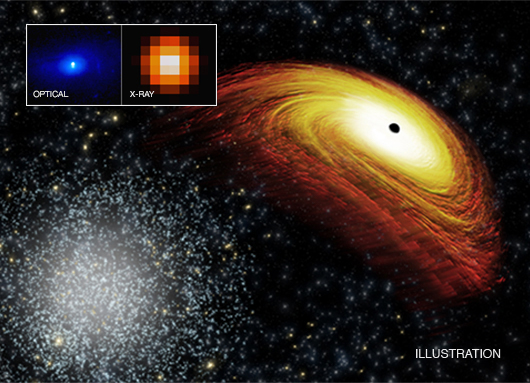
What's invisible, 160 million times more massive than the Sun, and on the move?
A newly discovered runaway supermassive black hole!
Supermassive black holes are just what their name suggests: really, really massive black holes. They can grow up to billions of times more massive than the Sun, possess immense power and have extreme eating habits. They will devour stars, rocky planets, even light — nothing is off the menu.
While smaller black holes can be caught wandering between the stars, supermassive black holes are normally only found at the very centre of galaxies. Which is why astronomers were surprised to spot a supermassive black hole moving away from the center of the galaxy.
Following a trail of clues, astronomers may have figured out what caused this unusual behavior. The galaxy containing this black hole was involved in a collision with another galaxy, millions of years ago. The two galaxies eventually calmed and merged together to make one larger galaxy, both bringing with them their own supermassive black hole.
But one galaxy wasn't big enough for the both black holes. The immense gravity of these objects may have pulled them towards each other, closer and closer, until they eventually crashed. The two black holes melded into one. This violent collision then sent gravitational waves — warps in space — crashing through the Universe.
If these waves emitted more strongly in one direction than others, the new black hole would have been sent in the opposite direction, an effect called "recoil". We see the same thing when a rocket launches: exhaust gases coming out of the engine nozzle at high speed push towards the Earth and propel the rocket in the opposite direction, towards the sky.
This gave the newly formed black hole such a large kick that pushed it out from the galaxy's center!
Cool fact: Our Solar System lies 25,000 light years from the core of our Galaxy and the supermassive black hole, Sagittarius A*..
Watch the video podcast
Do you want to learn more about this topic?
Visit the Chandra field guide or send us your questions in an email: cxcpub@cfa.harvard.edu
In cooperation with Space Scoop: Bringing news from across the Universe to children all around the world. Universe Awareness and the Chandra X-ray Observatory
| Children & Online Privacy |



